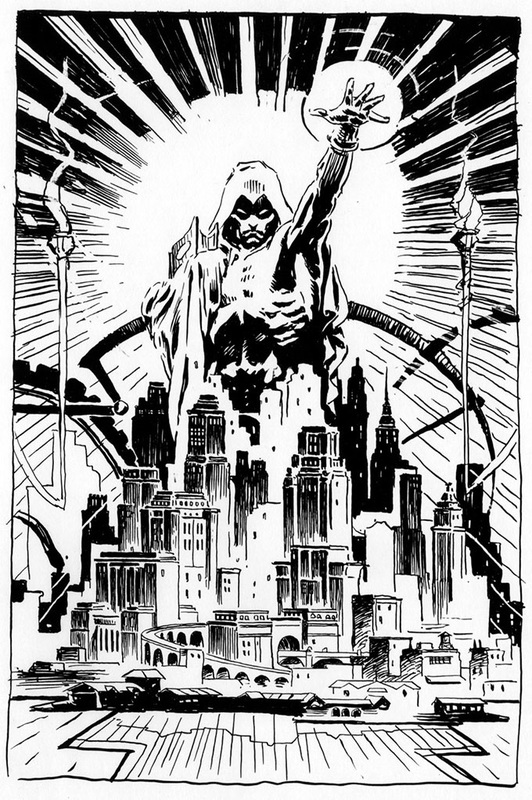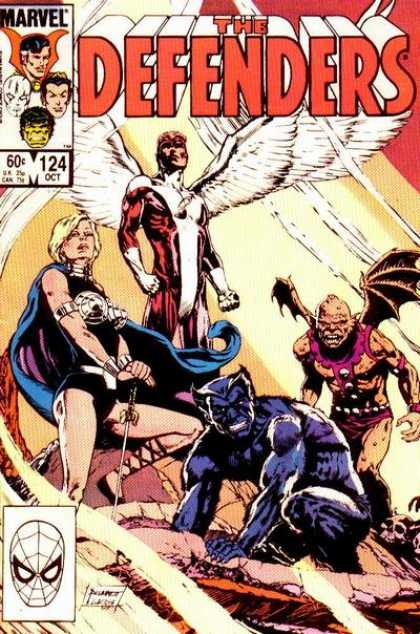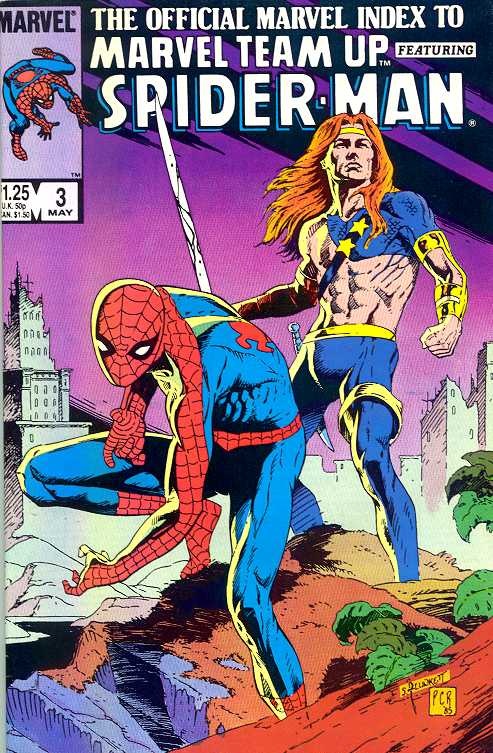|
Taking a break from reviewing Athens, Ohio, or Marvel work, Jim asked Sandy about his work on 1993's Spectre [Vol 3] #3 cover for DC Comics.
Sandy: I'd done some work for DC before I got a call to do this cover. Neal Adams helped get me my first job for the company. He had this deal with them -- if they gave a script to an aspiring artist he thought had promise, he would ink the resulting pencils, thus guaranteeing that even if the guy turned out not so promising, Neal would save the job with his inks. I think I had moved to Ohio by the time I'd received the assignment and never did meet the editor. We didn't establish the best of relationships but I don't remember the reason for the friction. Deadline issues? Quality? What I do remember is this: a couple days after the cover hit the stands, I got a phone a call. Picked up the receiver and a very distinctive voice came through the other end, "Hi, this is Harlan Ellison." Fans of science fiction of the late 60's through the 80's will recognize that name as a preeminent writer and media critic of the time. He was/is a tremendous fan of Golden Age characters and wanted to buy the original. I happily obliged. And thus, whatever the editor thought about the cover, I was feeling pretty smug, having received validation from such a esteemed fan favorite. I did a fair number of roughs before I managed to come up with something that expressed what I felt was the intrinsic nature of the character- an awful (in the biblical sense) instrument of divine judgement and retribution. Spectre Vol 3 #3-related images from Sandy's archive are below With the recent announcement that Netflix is bringing Marvel's "Defenders" to its services, Jim thought he would ask Sandy about a 1983 Defenders cover.
Sandy: Carl Potts was the editor on the Defenders book, a buddy from our days at Neal Adams' Continuity Studios, and if I recall correctly, he pretty much gave me free rein on the cover, letting me do a "symbolic" representation of the group. That is, the scene I came up with didn't have to depict any actual event in the issue. Even by superhero standards, the Defenders was a weird-ass group. I could never get a read on that book (though, yes, it might have helped if I had actually read any of the stories.) The original creators took the most unlikely characters and tossed them into the same title. And the composition of the group seemed to change with mind-spinning regularity. Fortunately, I was under no pressure to include all the team members on the cover and so I cherry-picked, selecting the ones I thought would work well together visually. Alan Weiss did another stellar job inking my pencils and I colored it, as I did all my covers. Years later, a fan commissioned me to do a recreation of the cover. This practice might sound odd to the uninitiated, but fans who missed out on buying the original of a favorite cover sometimes hire the artist to "recreate" the work for them. I have mix feeling about this idea. On the one hand, redrawing a piece gives you the chance to work out all the annoying flubs you committed the first time round. On the other hand, given my propensity for spending an absurd amount of time worrying about minutia, reworking a piece until I get it right isn't a good idea. When I'm at the board sometimes, late at night, I imagine myself some retched character from an Edgar Allan Poe story, neurotically reworking details no one will ever notice on a drawing that'll never be finished. Though I did improve some of the drawing in the recreated version of this cover, my preference is for the original, largely cause Alan's inks are just so gritty and rich with texture. Defenders #124-related images from Sandy's archive are below A few prompts from Jim (below), got Sandy to revisit his work on 1986's "The Official Marvel Index to Marvel Team-Up" #3.
Sandy: Thinking back, it's hard to remember how I got many of my jobs for Marvel. Most freelancers of the day learned that finding a pretext to hang out in an editor's office was a pretty effective way to snag a job. In other words, just try and place yourself in the way of an editor who's wandering the halls, looking for an artist to take an assignment. Like shooting the breeze with Carl Potts when Al Milgrom sticks his head in the office. Al: "Oh, I was thinking of giving you call." Me: "Yeah?" Al: "Yeah, a got a job you might like." Did Al really mean to call me? Most certainly, yes. Would he have remembered to if I hadn't hanging around with Carl. A lot more doubtful. This was a pretty good time at Marvel. The Direct Sales market was really taking off, editors were more willing to experiment now they were aiming at an older, more sophisticated audience, the company was still relatively small and since it's profits were still modest, the corporate culture hadn't descended yet. A pretty relaxed atmosphere. To me, Steve Ditko's vision of Spider-Man is the only one the matters. But that's not surprising since most everyone is attached to the version of a character they first discover in comics. There's a large and vocal generation of readers who feel no one could ever surpass John Romita on the title. Others feel that way about Todd McFarland. They're all wrong, of course. Ditko's dystopian view of teenage life and society gave the book a depth it never achieved again. His Peter Parker really spoke to the pain, frustration and loneliness many of the readers were experiencing as they struggled their way through adolescence. |
BLOGaboutPlunkett-fan Jim Harris interviewing Sandy about past and present projects. Archives
January 2021
Categories
All
|










 RSS Feed
RSS Feed